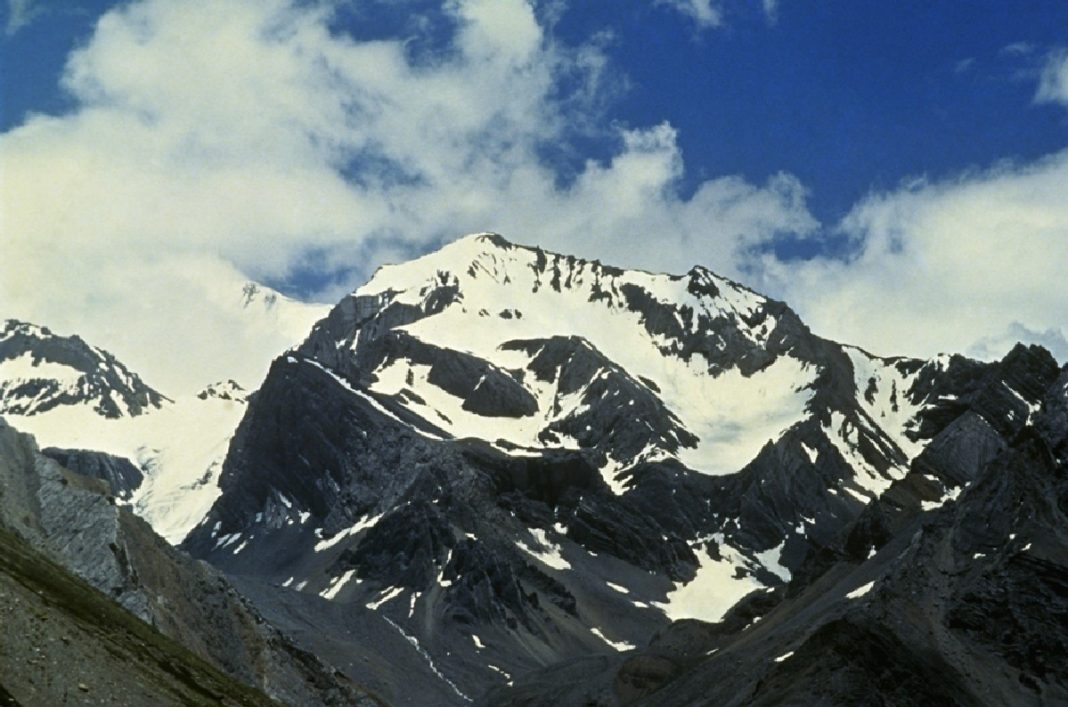The Himalayas (abode of snows) is the mystical dwelling of gods. Ancient texts, such as the Ramayana, the Puranas, the Vedas, the Mahabharata, all sing in unison of the glory and wonder of the Himalayas.
A large numbers of peaks and ranges in the Great Himalayas are named after Lord Shiva, the Lord of Mountains and his consort goddess Parvati. Mt. Shivaling, Trishul, Nanda Devi are a few of the very well known mountains named after lord Shiva and his family. The most famed and holiest mountain among all these is Mount Kailash (22028 feet, 6714 meters), and on top is the heavenly abode of Lord Shiva, who shares this lofty peak with his consort goddess Parvati.
Few mountains in the world can rival the grandeur of Mt. Kailash, the famed holy peak in western Tibet, this legendary snow shrouded rock dome is revered by four different religions as one of the most sacred pilgrimage destination in Asia.

Hindus regard Mt. Kailash as the earthly manifestation of Mt. Meru, their spiritual center of universe, the “World Pillar“, around which everything else revolves, its roots in the lowest hell and its top kissing the heavens. Sprawling below is the sacred Manasarovar, where a ritual bath will deliver a pilgrim to Lord Brahma`s paradise, and a drink of its holy water relinquishes the sins of a hundred lifetimes.
For the Jains, Mt Kailash is revered as this is the place where their first Prophet achieved Nirvana, i.e. enlightenment. Buddhist cosmography identifies Mt. Kailash with the mighty Mt. Sumeru, the central peak of the world. Mt. Kailash in is known Tibetan as Ghang Rimoche meaning Precious Jewel of Snow, or by its aboriginal name, Ti-Se.
From the slopes of Mt. Kailash a stream is said to pour in to Lake Manasarovar and from this lake flow four major rivers in four cardinal directions towards the ocean. These mythical rivers are associated with four rivers – the Indus, the Bramhaputra, the Karnali, and the Sutlej respectively.
The pilgrimage to Kailash and Manasarovar is considered to be one of the most difficult in Asia. The distances are tremendous, the weather particularly harsh, supplies almost non-existent, and bandits are constant worry. Nevertheless pilgrims come from far corners of Asia defying the hardships to walk the 52 kilometer circuit around Mt. Kailash, and 75 kilometer around lake Manasarovar. The best time for this pilgrimage is between the middle of May to the Middle to October.
The circuit around Mt. Kailash and Lake Manasarovar is covered in six days. The Mt Kailash circuit takes the pilgrims through Tarchen- Direbu- Zongzerebu and the Back to Tarchen. The circuit around Lake Mansarover covers Huore, Chugu, and Zaidi.


KAILASH PARIKRAMA –
The Kora or the Parikarama around Mt. Kailash starts at Tarchen, a small wind-blown settlement; the pilgrim circuit enters the Lha Chhu (Gods river) valley, a spectacular canyon. As the parikarama swings behind Kailash’s sheer northern face, the trail climbs to the Drolma La, the Dolma Pass (18,600 ft, 5670m), the highest point en route, and then descends quickly into the Lham Chhu Khyer valley before turning back towards Tarchen.
Shortly after the Dolma Pass, to the south of the path is a large lake, the Gouri kund (Tukja Tsu i.e. the Compassion Lake).
The sheer icy north face of Mt. Kailash is unveiled at Direbu. It is a common belief that walking or completing three or thirteen circuits is particularly auspicious. One circuit is said to purify all the sins of a life time. 108 circuits will bring enlistment during this life time. To go closer to the base of Mt. Kailash, one must have qualified by completing 13 circumambulations by the route.


MANASAROVAR PARIKRAMA –
South of Mount Kailash are the two lakes Manasarovar and Rakshash tal. They are the highest bodies of fresh water in the world, with Manasarovar at 4558 meters, fifty meters higher than Rakshash Tal. Manasarovar has been proclaimed as “The Pearl of the lakes of the world“ by noted writer Seven Hedin.
The two lakes are connected by a channel, Ganga Chu. Manasarovar is the larger of the two lakes (1330 square kilometers as compared to 224 square kilometers) and considered by both Hindus and Buddhists to be the more worthy of veneration. Buddhists believe that Queen Maya, Buddha`s mother, was carried here by the gods, and washed prior to giving birth to Buddha.
The circuit around the Manasarovar is longer than that around Kailash but is more or less completely flat. The starting point for the parikrama of Manasarovar is the village of Huore. The long walk down the eastern shore takes you through diverse and beautiful landscapes finishing at the Chugu or the Trugo monastery on the southern shore of the lake.
The next stretch of the parikrama entails a full day`s walk from Chugu to Tseti Lake at a place called Zaidi on the western shore. The Northern shore of the lake is not usually covered as part of the Parikrama because of marshes and cliffs that prevent one from approaching the shoreline.
The Kailash- Manasarovar Yatra is an extremely difficult pilgrimage and the obstacles the people meet in trying to get to here are readily attributed to the power of the mountain itself, which allows only those with sufficient spiritual preparation a glimpse of the magical presence.




Comments are closed.